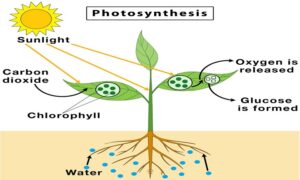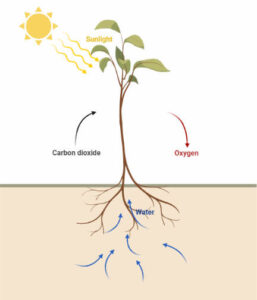Photosynthesis occurs in the chloroplast, found in the mesophyll cells of the leaves. There are 4 pigments involved in photosynthesis:
Chlorophyll a
Chlorophyll b
Xanthophylls
Carotenoids
We are all aware of the process of photosynthesis in small plants. Let us have a detailed look at the photosynthesis in higher plants notes to explore the process of photosynthesis in higher plants.
- A physiochemical process by which they use light energy to drive the synthesis of organic compounds. It is important because it is a 1-degree source of all food and responsible for the release of O2.
- Among normal leaf and variegated leaf (partially covered with black paper), normal leaf shows positive starch test. Similarly, among normal leaf and leaf enclosed in a tube containing KOH (absorb CO2), normal leaf shows the starch test.
Photosynthesis- Early experiment –
- Joseph Priestley (1733-1804) – Discovered O2 in 1774. The observed candle burning in the bell jar soon extinguishes, but when he placed the mint plant, it continued to burn.
- Jan Ingenhousz (1730-1799) – Sunlight is essential to plant the observed small bubbles of O2 in aquatic plants in sunlight.
- Julius von Sachs (1854) – Production of glucose when plants grow, he showed green substance is located in special bodies in the plant. He observed that glucose is stored as starch.
- TW Engelmann (1843- 1909) – He split light spectral component using prism & then illuminated green algae (Cladophora) placed in a suspension of aerobic bacteria (to detect O2). He observed bacteria accumulated mainly in the region of blue & red light of spectrum.
By mid-19th: CO2+H2O → [CH2O] +O2
Light Carbohydrate
- Cornelius van Neil (1897-1983) – Demonstrated photosynthesis in light-dependent reaction in which H2 from oxidizable compound reduces CO2 to carbohydrate.
2H2A+Co2 → 2A +CH2O+H2o
Light
In green plants, H2O is an H2 donor & oxidizes to O2. H2S is an H2 donor for purple & green Sulphur bacteria, and oxidation product is S or SO42- 6CO2+12H2O → C6H12O6+H2O+ 6O2
Where does photosynthesis occur?
- Chlorophyll aligns at the boundary of mesophyll cells to attain maximum light.
- Chloroplast is a double membranous structure consisting of grana, stroma, lamellae, stroma matrix.
- Membranous system trap light & synthesize ATP & NADPH.
- In the stroma, synthesis of sugar takes place, which converts to starch, indirectly light-driven – Dark reaction (carbon reaction). It depends on the product of the light reaction (ATP & NADPH).
- In thylakoid, a light reaction (photochemical) takes place, which is directly light-driven (light energy → Chemical in the form of ATP & NADPH).
Click Here for Complete Biology Notes
Pigments in Photosynthesis –
- Have the ability to absorb light at a specific wavelength.
- Chlorophyll a (bright or blue-green); chlorophyll b (Yellow-green); Xanthophyll (Yellow); Carotenoid (Yellow to Yellow expel).
- Maximum absorption of chlorophyll ‘a’, i.e.- in blue & red region→ High Photosynthesis. Maximum photosynthesis occurs at 430 nm & 662 nm.
- Chlorophyll b, xanthophyll, carotenoids – accessory pigments. They transfer energy to chlorophyll →, enable wavelength of incoming light to be utilized, protect chlorophyll a from photo-oxidation.
Light Reaction –
- Absorption of light energy→ Photolysis of H2O àO2 relaxes →Formation of ATP & NADPH.
- Pigments are organized into 2 light-harvesting complexes (LHC) within Photosystem I (PS I) & Photosystem II (PS II).
- LHC is made of 100S of pigment bound to protein. Each Photosystem has all pigments (except 1 mol. Of Chl. A) forming LHC – antennae.
- These pigments help in absorbing different wavelengths.
- One chlorophyll molecule forms the reaction center.
- In PS I, the reaction center of Chlorophyll ‘A’ has more absorption at 700 nm, So P700, while in PS II, it is 680 nm, so P680.
The electron transport –
- When PS II absorb 680 nm, electrons excite and jump into an orbit further from at nucleus, where they are picked by an electron acceptor, which passes then to an ETS consisting of Cytochromes. It is downhill in terms of the lower redox scale. Electrons are not used up but passed on to pigments of PS I.
- Simultaneously, an electron in PS I excited & transfer to another acceptor having More redox value, move downhill to a molecule of energy-rich NADP+ & H+ electron reduce NADP + NADPH.
- Z Scheme – Transfer of electron, from PS II, uphill to acceptor, down the electron transport chain to PS I, excitation of the electron, transfer to another acceptor, downhill to NADP+ →NADPH + H+.
Splitting of Water –
- An electron that was moved from PS II must be replaced. It is achieved by electron due to splitting of water & for PS I is by excited electron of PS II.
2H2O → 4H + O2 + 4 e-
Cyclic & non- cyclic photophosphorylation –
- Photophosphorylation – Synthesis of ATP from ADP & Pi in the presence of light.
- When both, first PS II & PS I work – e.g., non-cyclic photo-phosphorylation. E.g., Grana.
- When only PS I is functional, the electron is calculated within the photosystem & phosphorylation occurs due to the cyclic flow of electrons. E.g.- Stroma Lamella, lack PS II and NADP reductase. An excited electron does not pass on to NADP+ but cycled back to PS I through TS. It results in ATP synthesis. It also occurs when only light of wavelength beyond 680 nm is there.
Chemiosmotic Hypothesis – Mechanism of ATP synthesis. In photosynthesis, Proton accumulation is towards the inside of the membrane, while in respiration, it’s in the intermembrane space of mitochondria.
Steps causing protein gradient –
- As H2O split on the inner side(lumen), so H+ accumulate within the lumen.
- As electrons move through photosystems, protons are transported because the ten acceptors of the electron are located on the outer side, which transfers its electron to an H carrier instead of an electron carrier. So, removes H+ from stroma which transporting electron and releases H+ on the inner side.
- NADP is located on the stroma side. Along with electron from acceptor of electron of PS I, H+ are necessary for NADP+ reduction. So, H+ was removed from the stroma.
- Accumulation of H+ in lumen & decrease in the stroma.
- Breakdown of this gradient leads to ATP synthesis. It is due to the movement of H+ across the membrane to stroma through the transmembrane channel of CF0 (facilitated diffusion, embedded in the thylakoid membrane).
- ATP synthase has 2 parts – CF0 & CF1 (outer surface).
- Breakdown of gradient provides energy to cause a conformational change in CF1 particle of ATP, which synthesize high molecule of ATP.
- Chemiosmosis requires membrane, H+ pump, H+ gradient, ATP synthase. Energy to pump H+ across the membrane, ATP channel to allow diffusion.
- Along with NADPH produced by the movement of an electron, ATP will be used in the biosynthetic reaction in the stroma for fixing CO2, sugar synthesis.
Where are ATP & NADPH used?
- Products of light reaction. ATP, NADPH, O2. These are used in a dark reaction which is also called the biosynthetic phase, as an involved synthesis of food.
- Melvin Kelvin – Used radioactive 14c in algal photosynthesis & discovered that the first product of CO2 fixation is three-carbon compounds and called it Calvin cycle and product 3 – phosphoglyceric acid (PGA).
- other scientists also worked & found a new product in CO2 fixation, i.e., organic acid – Oxaloacetic acid (4-c)- C4 pathway.
The primary acceptor of CO2 –
- The scientist showed that the acceptor molecule was S-C ketose sugar- Ribulose bisphosphate (RUBP).
- But they tried to find a 2- C compound as the First product was C3 acid.
The Calvin Cycle – It involved three steps-
1 . Carboxylation- as CO2 is added.
- CO2 is utilized for carboxylation of RUBP carboxylase, which results in 2 molecules of 3- PGA (3C).
- Since this Enzyme has oxygenation activity so-called RUBP carboxylase oxygenase or RUBISCO.
2. Reduction – Formation of triose phosphate precursor to glucose.
- Two molecules of 3 phosphoglycerates are phosphorylated to 1,3 bisphosphate (2 mol.) in the presence of phosphoglycerate kinase and utilizing 2 ATP.
- Two molecules of 3 bisphosphates are reduced to molecular of Glyceraldehyde 3 – phosphate by Glyceraldehyde 3- phosphate dehydrogenase & NADPH.
- Out of 12, 2 are used to make one molecule of glucose, and the rest 10 (3*10= 30 carbon) are used for six molecules of RUBISCO 1,5 bisphosphate (S-C).
- 1 ATP is utilized for 1 RUBP.
3. Regeneration –
- For 1 CO2, 3 ATP & 2 NADPH are needed.
- For 6 CO2, 18 ATP & 12 NADPH are needed à one glucose molecule. Out →18 ADP + 12 NADP.
The C4 pathway –
In monocotyledon (Dry tropical region) – Maize, Jawar, Bajra
- C4 plants – tolerate high temperatures, respond to higher intensities, lack photorespiration, and increase biomass productivity.
- Discovered by Hatch & Slack (1966).
- Large cell around vascular bundles – Bundle sheath cells (more chloroplast) thick wall impervious to gaseous exchange (suberin, less space). Such leaves have Kranz anatomy. (Kranz- wreath). So, dark green color.
- CO2 is fixed in mesophyll. Pyruvate is converted to phosphonyl pyruvate in in presence of pyruvate phosphate Di kinase & ATP. PEP + CO2 forms Oxaloacetate (4C) in presence of PEP Carboxylase. It ensures carboxylation at low temperature as has affinity for CO2 than RUBISCO.
- RUBISCO is absent in mesophyll of C4.
- Oxaloacetate is converted to malate or aspartate by 1 NADPH and transported by bundle sheath cell through plasmodesmata where it is decarboxylated back to pyruvate which releases CO2 and Pyruvate is transported back to mesophyll and converted to PEP & continued.
- Released CO2 is fixed in bundle sheath which is rich in RUBISCO through C3 Cycle (lack PEP case).
- Two C4 plants undergo carboxylation twice (mesophyll & bundle sheath).
- Though C4 is more expensive but efficient for plants living in hot & dry region as chlorophyll cells are (+) both in bundle sheath & palisade Parenchyma.
Photorespiration
- Decrease efficiency of photosynthesis.
In C3 – RUBISCO- most abundant enzyme.
- Though RUBISCO shows more affinity to CO2 than O2 still can bind to O2 depending on concentration.
- It occurs in dry conditions, High temperatures when CO2 concentration decreases due to utilization in the C3 cycle.
- The active site of RUBISCO combined with O2 to form 1 PGA and one phosphoglycolate (2C). Phosphoglycolate is removed from the chloroplast. It decreases CO2 fixation.
- It doesn’t result in the release of ATP, sugar, NADPH but utilizes energy to form ATP and release CO2, So a wasteful process.
In C4, Photorespiration does not occur due to unique plant anatomy.
- They lack RUBISCO mesophyll but have PNPase, which helps in carboxylation & C4 cycle & then C3. Also, C3 takes place in a bundle sheath, which has walls impervious to gases. So, help in increasing the concentration of CO2 near RUBISCO. So, decrease oxygenation of RUBISCO. So, photosynthesis is high productive in C4 plants.
Related Posts
- Phylum Porifera: Classification, Characteristics, Examples
- Dissecting Microscope (Stereo Microscope) Definition, Principle, Uses, Parts
- Epithelial Tissue Vs Connective Tissue: Definition, 16+ Differences, Examples
- 29+ Differences Between Arteries and Veins
- 31+ Differences Between DNA and RNA (DNA vs RNA)
- Eukaryotic Cells: Definition, Parts, Structure, Examples
- Centrifugal Force: Definition, Principle, Formula, Examples
- Asexual Vs Sexual Reproduction: Overview, 18+ Differences, Examples
- Glandular Epithelium: Location, Structure, Functions, Examples
- 25+ Differences between Invertebrates and Vertebrates
- Lineweaver–Burk Plot
- Cilia and Flagella: Definition, Structure, Functions and Diagram
- P-value: Definition, Formula, Table and Calculation
- Nucleosome Model of Chromosome
- Northern Blot: Overview, Principle, Procedure and Results

















